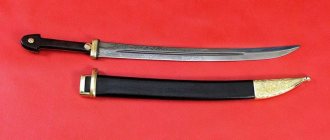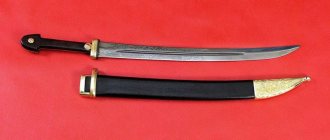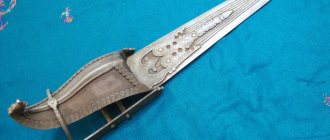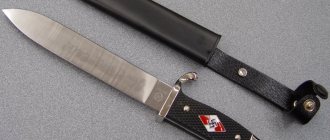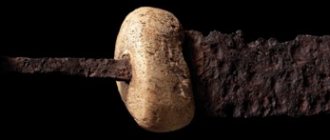The world of historical edged weapons keeps many interesting secrets and mysteries. There are many amazing blades that make the most advanced experts and historians shrug their hands helplessly. An example of such a weapon is the Italian cinqueda - either a sword or a dagger, which suddenly appeared in Northern Italy at the end of the 15th century and a hundred years later also quickly went out of use. You are unlikely to confuse this weapon with any other. Its shape is very reminiscent of the swords of ancient Greek and Mycenaean warriors. Historians still cannot understand what exactly prompted the Italian gunsmiths to create this “device.”
Moreover, the cinqueda is absolutely out of the general “trend” in the development of bladed weapons of that era: the gradual transition from heavy swords to swords and rapiers, intended primarily for piercing strikes.
But let's talk about everything in order.
History of the stiletto
It is believed that the first stilettos appeared during the Renaissance, however, they acquired forms close to modern ones only in the 12th century . It was during this period that the stiletto knife became widespread in Italy.
The forefather of this product was the miseriordia dagger, which was used to finish off a dying enemy in order to save him from suffering. The blade had a small blade with a three or tetrahedral cross-section and a small cross.
During the Middle Ages, forges achieved great success, so armor could withstand blows from swords and daggers. But the stiletto could pass through even the densest armor; it was made precisely for this purpose. Another version says that the stiletto was developed due to the fact that there was no longer a need to use a shield. Since the fighter’s left hand was free, it was occupied with a compact blade that could repulse the attacker’s sword. The weapon was also used for the purpose of delivering a covert strike.
The peak of the stiletto's glory came during the Renaissance. The stiletto was actively used in Italy since the 12th century as a weapon for the left hand during duels. Such daggers were actively used for defense and attack.
Ancient world[edit]
My first thought on the topic “Isn’t my knife too short?” flew into the head of an unknown Bronze Age blacksmith. But, since only bronze was available to him, it turned out to be impossible to make a truly long blade out of it. Therefore, the “swords” of the Bronze Age (Ancient Egypt, Ancient Greece during the “Dark Ages”, Mesopotamia) are actually, at best, the length of a modern mid-range machete.
- Khopesh (or khopesh) is one of the very first types of bronze long-bladed weapons. The word itself is ancient Egyptian, but archaeologists have found similar ones in Mesopotamia. This blade is a sickle with external, internal or double sharpening, at the end of a thick bronze stick with a handle. The trick with a bronze stick made it possible to deceive the properties of bronze and move the blade (which, remember, could not be made long) away from the warrior’s hand. Therefore, it was possible to chop with khopesh even from a chariot.
- Kopis, or makhaira - despite the similarity of the name with the khopesh, this Greek weapon was more like the modern kukri. Moreover, some researchers believe that kukri is the same kopis that came to Nepal from the Hindus, and they inherited from the army of Alexander the Great. And in Ancient Rome they learned to make such “cucris” from iron and called them falcatas.
- Xiphos is also a Greek bronze blade, only straight, leaf-shaped, with a weighted end and up to 80 cm in size.
Finally, the Iron Age began. The largest empire in Europe this century was the Roman. The Romans created a large regular army, and included several types of iron weapons.
- Gladius (or gladius) is the most famous Roman sword, short and straight. It is also very reminiscent of a Caucasian dagger, only a little larger - which is why it is considered a short sword. The short length made the gladius a very convenient weapon for a foot formation; It was to him that gladiators also owe their name - bloody athletes who fought for the amusement of the public.
- Falcata is also an Iberian gladius. See "kopis" above.
- Spatha - the first true long sword, spatha was the weapon of the auxilii - mounted Roman warriors recruited from among the barbarian tribes of the Celts and Germans. It was the Celts who invented the spatha, but in the hands of the Roman auxiliaries it received improvements, in particular, it acquired a sharp end. The spatha was a sword with a blade of a completely classical shape, but with a hilt like a gladius - the guard was primitive, small and semicircular. Since the Germans soon captured the Western Roman Empire, it was their favorite sword - the spatha - that became the prototype for all swords of the Middle Ages.
In addition to Roman weapons, there were other interesting examples
- Romthea is an iron two-handed sword of the Thracians - a people who lived in South-Eastern Europe north of Greece - with a long handle and a single-edged, slightly curved blade. The first one, by the way, is a real two-hander!
- Akinak is a short (40-60 cm) iron sword of the Scythians.
Design
Like any type of bladed weapon, a stiletto knife has a number of specific design features that determine its class. And although the stiletto has many modifications, it has unchanging features, namely:
- No blade . The knife was designed for inflicting puncture wounds, so it does not require a cutting edge.
- Round or faceted blade . The round one was easier to manufacture, but there was a high risk that it would break upon impact with the armor. The diamond-shaped or triangular shape acts as stiffeners.
- Reinforced point . Since it is the piercing part of the weapon that delivers the blow, it must be additionally hardened.
- Reinforced ricasso allows the gun to withstand impacts with steel. The place where the blade connects to the guard is compacted, which allows you to strike the thickest armor. The guard has no decorative elements, as it is intended to intercept an enemy strike.
- The handle is thin, rather short, and fits perfectly into the size of the palm.
Classic stiletto with a fixed blade.
Due to the specific design, the force when striking is concentrated at the point of contact . If the strength of the knife is sufficient, then the penetrating power of such a weapon will surpass any model. Typically, the blade length of a classic blade is 230-250 mm, which is enough to keep the enemy at a safe distance.
In addition, there are modifications with a more serious blade, so in Spain the length of the stiletto reached 270 mm, in Germany - 370 mm, in France even 450 mm, such a product looked more like a shortened sword than a stiletto.
Manufacturing materials
The classic stiletto is quite simple to manufacture and does not require the use of special high-tech alloys. During the Middle Ages, the basis for the blade was an iron or steel rod. Of course, the use of higher quality metal allows you to significantly increase the striking force of the weapon. Thus, to use the blade in an urban environment, where opponents did not have serious armor, stilettos made of cheap alloys were used. Expensive steel was needed for duels or military operations.
A large number of copies of the knife are a solid metal product. This manufacturing method makes the stiletto more stable, since the impact energy falls on the entire surface. Another production method is to insert the blade into a prepared handle.
The stiletto handles received a huge range of materials for manufacturing. The poorer sections of the population were content with wooden options, sometimes covered with leather or fabric for convenience. The hilts of rich people's weapons were often cast from gold or silver and decorated with a scattering of stones. Particularly chic were the ivory pieces.
Eastern variants of European stilettos
Eastern countries had their own modifications of stilettos. Even in the first millennium BC, China actively used awl-shaped tools to pierce armor. Depending on the length of the blade, such a weapon was actively used by military and professional killers. A narrow blade with several edges easily tore the chain mail; usually the knife was pulled out at the most unexpected moment and a fatal blow was delivered.
Among the many modifications of weapons, Japanese knives can be noted; they are divided into three categories:
- aiku-chi is a knife without a guard;
- yoroi dosha, the knife is equipped with half a guard;
- tanto, a knife for eliminating an enemy after being wounded, the weapon has a shape similar to a katana. The guard in some models had pointed edges.
Japanese aiku-chi stiletto.
Most models acted as a complement to the samurai sword. Merchants, ninjas and ashigaru soldiers did not rely on swords; they used blades that were more similar to European stilettos:
1. Shaken , this is a long nail that was used for throwing and in everyday life;
Shaken stillet knife.
2. Kozuka – used in everyday life and for throwing;
Kozuka stillet knife.
3. Kogai , used as a secret weapon, they also often used it to finish off the wounded. There were also models with four edges, which inflicted horrific wounds;
Kogai stiletto knife.
4. Kansari , 20-centimeter stilettos in the form of hair knitting needles, are the favorite weapon of geishas and female ninjas.
Kansari stiletto knife.
Titles[ | ]
Members of the Italian Army patrol the center of Catania on an IVECO all-terrain vehicle (September 2022)
- General ( general
) - Corps general ( generale di corpo d'armata
) - Divisional general ( generale di divisione
) - Brigadier General ( generale di brigata
) - Colonel ( colonnello
) - Lieutenant Colonel ( tenente colonnello
) - Major ( maggiore
) - Prime captain ( primo capitano
) - Captain ( capitano
) - Lieutenant ( tenente
) - Second lieutenant ( sottotenente
) - Cadet ( allievo ufficiale
) - Premier Lieutenant Marshal ( primo maresciallo luogotenente
) - Prime Marshal ( primo maresciallo
) - Chief Marshal ( maresciallo capo
) - Ordinary Marshal ( maresciallo ordinario
) - Marshal ( maresciallo
) - Chief Petty Officer ( sergente maggiore capo
) - Sergeant major ( sergente maggiore
) - Sergeant ( sergente
) - Chief Corporal Major ( caporale maggiore capo
) - Prime Corporal Major ( primo caporal maggiore
) - Corporal Major ( caporale maggiore
) - Corporal ( caporale
) - Soldier ( soldato
)
Generals
| Categories | ||||
| NATO | ||||
| Insignia | ||||
| Rank of Northern Forces of Italy | Generale | Generale di corpo d'armata | Generale di divisione | Generale di brigata |
| Russian translation | General | Corps General | Divisional General | Brigadier General |
| Rank of the Russian Armed Forces | Army General | Colonel General | Lieutenant General | Major General |
Officers
| Categories | ||||||||
| NATO | ||||||||
| Insignia | ||||||||
| Rank of Northern Forces of Italy | Colonnello | Tenente colonnello | Maggiore | Primo capitano | Capitano | Tenente | Sottotenente | Allievo ufficiale |
| Russian translation | Colonel | Lieutenant colonel | Major | Premier Captain | Captain | Lieutenant | Ensign | Cadet |
| Rank of the Russian Armed Forces | Colonel | Lieutenant colonel | Major | No | Captain | Senior Lieutenant | Lieutenant | Ensign |
Classic and throwing stilettos
Throwing stilettos are usually triangular in shape; the handle has a hole for a cord, which will help return the weapon in case of an unsuccessful throw.
Few people know that the bayonet for rifles used by the Russians is a modern modification of the stiletto. More soldiers died from such an inconspicuous weapon than from wide European bayonets.
US soldiers in the period 1914-1918 were armed with a stiletto - the M1918 brass knuckle knife. The blade of this weapon was 0.5 cm thick, and the brass knuckle-shaped handle was used for punching. Similar models also had double-sided sharpening.
Italian kitchen knives
A variation on the theme of this irreplaceable attribute in the life of any person in Italian design is represented by knives from Del Ben. For more than 50 years, this company has been delighting with its unusual models, stylish solutions and high quality.
For the manufacture of a knife blade, steel grades such as RwL 34 and PMC 27 are traditionally used. They are distinguished not only by their high hardness (up to 62 Rockwell units), but also by a sharp blade edge, which is easily sharpened, has increased wear resistance, and anti-corrosion properties. The handle of the knife also plays an important role in the design of the model. Preference is given to natural materials: wood of different types of wood (oak, ebony), deer and buffalo horn. This design allows you to create not only a high-quality, but also a very attractive and stylish product, designed to show the good taste of its owners.
The range of variations presented is amazingly diverse. The collections include special kitchen knives for all occasions: for cutting roast beef, tomatoes, cheese, peeling vegetables and fruits, various types of fish and meat. Universal chef models are made in various styles, with different blade widths and thicknesses.
There are also original solutions. A striking example of this is the Primitive model, made in the form of a primitive silicon knife. The exclusive shape not only does not detract, but, on the contrary, emphasizes the cutting properties of the product. Thanks to its ergonomic design and high-quality polished steel, this knife perfectly cuts different types of products with minimal effort.
Stilettos of the 20th century and their features
During the First World War, soldiers from Europe actively used trench knives. Thanks to this, the classic stilettos of the 15th century received a new breath. The fighters independently created their own weapons from rifle bayonets and fragments of sabers. In the trenches, a narrow, straight blade proved to be very effective.
If we talk about factory products from the period 1914-1918, the most popular was the naval dagger. Moreover, it looks like a dagger with a short cross-shaped guard, the main purpose of which was to deliver stabbing blows.
20th century stiletto knife.
Today there are more modern interpretations, for example, a folding stiletto knife. Such products usually retain their characteristic shapes, but the stiletto switchblade has a cutting part, which provides more practical use. The Italian switchblade is quite popular among tourists.
Is it considered a melee weapon?
The main feature by which a knife can be considered a bladed weapon is the size of its blade. The legislation of the Russian Federation provides for a length limit of 90 millimeters. In other words, if this element of the knife is shorter, the weapon has a purely civilian purpose and can be easily carried and stored. Exceeding the established limit by even a millimeter automatically equates a steel product to a bladed weapon capable of causing serious harm to a person and his health. According to this parameter, the stiletto is subject to restrictions on use.
Even if the stiletto did not fit the category of edged weapons, it seems unlikely to be used for domestic needs. It will not be possible to cut anything with this knife, since it was originally made as a murder weapon. In most cases, Italian stilettos are examples of private weapons collections, as well as museum exhibits associated with the Middle Ages and the Renaissance. As for the sharpening parameter, here this knife is equivalent to an ordinary awl, but due to the elongated blade, its use is unacceptable.
Stiletto has come a long way in development and has emerged as a real murder weapon. Nowadays, representatives of this family have mostly transformed into stiletto-like daggers with a beautiful guard and an elegantly crafted handle.
Features of using stilettos
During the Renaissance, the stiletto became common among assassins. If we talk about the Spanish modification, the length of the blade was sufficient to inflict a fatal wound to the heart, and the compact size of the weapon made it possible to quietly hide it in the sleeve.
The modification of the stiletto used by the killers usually did not have a guard, and the blade was inked so that it did not give off glare in the dark. In most cases, the killer struck with his fist after holding the blade between his fingers; such a blow usually led to death.
There were frequent cases when, for a 100% effect, the blade was generously smeared with poison, so the victim died even from a minor injection.
In all cases, the wounds caused by the stiletto were invisible, since there was very little blood. Removing the stylet from the wound contributed to the closure of the wound, so the victim died from internal hemorrhage. The blade gained famous fame as a weapon of killers, since for success it was necessary to have a good understanding of the anatomy of the body so that the blow would bring the expected result, as well as to have the skills to use a stiletto.
Previous
Combat knivesWhat is a tactical knife: a combat weapon or a survival tool
Next
National knivesSoviet folding knives
In popular culture
- Novel; Stiletto
, a 1960 film by Harold Robbins about a mob hitman, was adapted into the 1969 film
Stiletto
. - In the Motley Crue's Girls Girls Girls music video, Tommy Lee pulls out a Stiletto switchblade.
- In the movie The Warriors,
the punk leader uses an Italian stiletto to attack the warrior leader while they are hiding in a subway bathroom. Additionally, in the Warriors script there is a gang known as the Stilettos. - In the fantasy book series Gentlemen Bastards, the main character Locke uses a stiletto as his main weapon.
- In the film Gladiator
, Commodus uses an anachronistic stiletto to stab Maximus. - In the Nick Carter series of spy novels, one of Carter's signature weapons is a 400-year-old stiletto named Hugo, said to have been made by Benvenuto Cellini.
- A stiletto-style switchblade is used in the knife fight scene in West Side Story
. - In both the 1957 and 1997 film versions of Twelve Angry Men
, a stiletto-style knife is a key plot point and a central piece of evidence in the murder trial of a delinquent teenager. - Billy Joel's 1978 album 52nd Street
contains the song "Stiletto" about a relationship with a woman reminiscent of facing an enemy with this type of knife, and her skill in using it. - The GI Joe: A Real American Hero
toy line produced by Hasbro featured a vehicle called the Stellar Stiletto. It was an expendable, reusable space rocket used by the Cobra team. It was long and narrow, with a pointed nose cone. He is featured in a comic book series storyline that involves international espionage. - In the British animated series Danger Mouse,
the main henchman of the villain Baron Silas Greenback was a crow named Stiletto Mafia. He spoke with an Italian accent, although it was changed to Cockney for American distribution. - In the book Eye of the Needle by Ken Follett, the main character uses a stiletto as his main weapon.
- In Expendable,
Jason Statham's character, Lee Christmas, uses a switchblade style stiletto in a knife throwing fight against Mickey Rourke's character, the tool. - In the Dick Tracy
, the revenge-seeking wife of the infamous villain Flattop Jones Sr. was named "Stiletto", a feminine form of "stiletto". She was a skilled knife thrower and used stilettos for both circus and criminal purposes. - In the Lemony Snicket series Unfortunate Events,
Count Olaf's girlfriend, Esme Misery, wears stiletto-heeled shoes with heels replaced by bladed stilettos. - The video game character Sombra from the video game Overwatch
was originally meant to use hairpins as a weapon. - In the video game Counter-Strike: Global Offensive, there is an available hand-to-hand combat option with a stiletto knife.
- Damian, a half-elf fighter played by Ashley Johnson, uses daggers with two stilettos in one shot. Darrington's Brigade - Critical Role.

